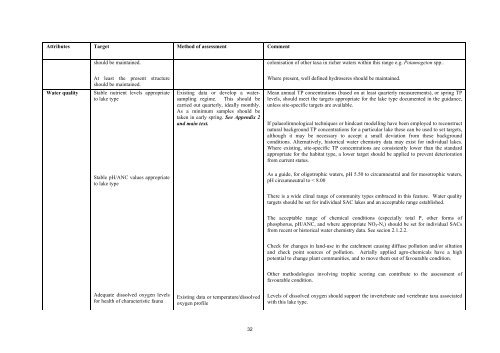Common Standards Monitoring Guidance for ... - JNCC - Defra
Common Standards Monitoring Guidance for ... - JNCC - Defra
Common Standards Monitoring Guidance for ... - JNCC - Defra
You also want an ePaper? Increase the reach of your titles
YUMPU automatically turns print PDFs into web optimized ePapers that Google loves.
Attributes Target Method of assessment Comment<br />
should be maintained.<br />
colonisation of other taxa in richer waters within this range e.g. Potamogeton spp..<br />
At least the present structure<br />
should be maintained.<br />
Where present, well defined hydroseres should be maintained.<br />
Water quality<br />
Stable nutrient levels appropriate<br />
to lake type<br />
Existing data or develop a watersampling<br />
regime. This should be<br />
carried out quarterly, ideally monthly.<br />
As a minimum samples should be<br />
taken in early spring. See Appendix 2<br />
and main text.<br />
Mean annual TP concentrations (based on at least quarterly measurements), or spring TP<br />
levels, should meet the targets appropriate <strong>for</strong> the lake type documented in the guidance,<br />
unless site-specific targets are available.<br />
If palaeolimnological techniques or hindcast modelling have been employed to reconstruct<br />
natural background TP concentrations <strong>for</strong> a particular lake these can be used to set targets,<br />
although it may be necessary to accept a small deviation from these background<br />
conditions. Alternatively, historical water chemistry data may exist <strong>for</strong> individual lakes.<br />
Where existing, site-specific TP concentrations are consistently lower than the standard<br />
appropriate <strong>for</strong> the habitat type, a lower target should be applied to prevent deterioration<br />
from current status.<br />
Stable pH/ANC values appropriate<br />
to lake type<br />
As a guide, <strong>for</strong> oligotrophic waters, pH 5.50 to circumneutral and <strong>for</strong> mesotrophic waters,<br />
pH circumneutral to < 8.00<br />
There is a wide clinal range of community types embraced in this feature. Water quality<br />
targets should be set <strong>for</strong> individual SAC lakes and an acceptable range established.<br />
The acceptable range of chemical conditions (especially total P, other <strong>for</strong>ms of<br />
phosphorus, pH/ANC, and where appropriate NO 3 -N,) should be set <strong>for</strong> individual SACs<br />
from recent or historical water chemistry data. See secion 2.1.2.2.<br />
Check <strong>for</strong> changes in land-use in the catchment causing diffuse pollution and/or siltation<br />
and check point sources of pollution. Aerially applied agro-chemicals have a high<br />
potential to change plant communities, and to move them out of favourable condition.<br />
Other methodologies involving trophic scoring can contribute to the assessment of<br />
favourable condition.<br />
Adequate dissolved oxygen levels<br />
<strong>for</strong> health of characteristic fauna<br />
Existing data or temperature/dissolved<br />
oxygen profile<br />
Levels of dissolved oxygen should support the invertebrate and vertebrate taxa associated<br />
with this lake type.<br />
32
















